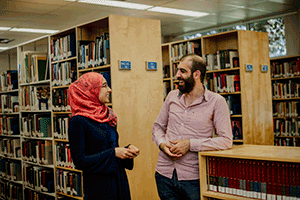Ready to learn more?
Get all the details straight to your inbox!

Living in The Student Village at Luther College, our student residence, comes with a choice of healthy, nutritious meal plans. That means no grocery shopping, no meals to cook, and no dirty dishes to worry about. You can focus on your studies and wellness!

The Luther Library has over 24,000 items in its collection, 5,000 books checked out per year, and 7,000 students who come through its door per month.

Smaller class sizes at Luther College means more individualized attention and better connections with your professors, classmates, and academic advisors.

Luther College is recognized for its high standards of teaching, focused research, and one-on-one academic advising. We value and protect this heritage of excellence in scholarship, freedom of inquiry, and faithful seeking after truth.

Our student residence, The Student Village at Luther College, welcomes residents from ALL post-secondary institutions in Regina. Rooms come with a meal plan, free laundry, free wi-fi, and a great sense of community.

Luther College appeals to students who want to study in a safe, nurturing, and inclusive environment. We welcome students of all faiths, ethnicities, backgrounds, religions, genders, and sexual orientations.

Luther College offers Bundles programs that group together first-year students and classes to give you a great start and help ease the transition from high school to university.

Every degree program at Luther College offers a study abroad option and an optional experiential learning component where you gain real world experience and get paid while going to school!
Get all the details straight to your inbox!
By Lori Beaman
The language of tolerance and, more recently, reasonable accommodation, has come to dominate popular and legal discourse related to the management of or response to religious diversity. Although tolerance has been a bit less ‘tolerated’ recently, reasonable accommodation has gained status as the mode of framing any discussion of the everyday negotiation of religious diversity. What is wrong with ‘tolerating’ others as the basis for dialogue? Why is accommodating someone problematic?
In his 1689 “A Letter Concerning Toleration” John Locke advocated for toleration, except for atheists and Roman Catholics. This exemption illustrates the core problem with basing the negotiation of religious difference on tolerance or accommodation: both frameworks create a hierarchical positioning of ‘us’ and ‘them’ that is conceptually unavoidable. There have been some powerful challenges to the use of tolerance to negotiate difference by such scholars as Wendy Brown (2006, 2010) and Ann Pellegrini and Janet Jakobsen (2004). The latter state: “what does it feel like to be on the receiving end of this tolerance? Does it really feel any different from contempt or exclusion?” (14). Alan Wong (2011) has asked “reasonable according to whom?” Day and Brodsky (1996) wrote an insightful criticism of the legal use of reasonable accommodation almost 20 years ago. Since then reasonable accommodation has expanded rather than contracted in use in the context of law (and elsewhere). Criticisms have also come from outside of the academic community as some religious leaders have called into question the use of tolerance as a beginning place for interfaith dialogue which has often been premised on the idea of ‘tolerance’ as though it were a good thing or the best we could expect of people who have different ideas, beliefs and practices. (2)
A slightly broader view may lead to the conclusion that the specific ways in which tolerance and accommodation are used in various societies means that it is possible that they include notions of equality. Scholars such as Tariq Modood (2005) and Natasha Bakht (2012, 2009) take this approach, for example. Similarly, the point can be made that tolerance and accommodation are better than nothing. Veit Bader (2011), for example, argues that “Gritted teeth tolerance and collective tolerance are part and parcel of any minimalist morality and of any decent polity” (17). So, if those who argue that tolerance and accommodation are better than nothingmean that it is better than outright hatred or refusal to engage at all with those who are marked as being ‘other’, then they are probably correct. My argument, though, is that in the Canadian context we might want to argue that tolerance and accommodation are not good enough, especially given our constitutional commitment to multiculturalism (3), approaches to human rights and emphasis on equality. In this context, is it possible to create a different framework? If not tolerance and reasonable accommodation, then what?
If the main problem with tolerance and accommodation is that they create a hierarchy or a sedimentation of unequal power relations, how can that framework be re-imagined to structure a different kind of relationship? And what would or should that relationship look like? I have proposed the idea of deep equality to attempt to shift the framework for conversations about diversity away from tolerance and accommodation. The parameters of this concept are still under construction, but its core element is a commitment to a complex understanding of diversity that emphasizes similarity (Mahajan 2010a, 2012b) on the conceptual continuum of sameness and difference. Similarity can and should shift, depending on the parties involved. If it doesn’t, it can too easily lapse into sameness, or disrespect for difference. The idea of a continuum recognizes the shifting possible interpretations of equality, which can range from formal equality emphasizing sameness (a model perhaps most starkly represented by the laicite approach of France) to substantive equality with its emphasis on difference.
Feminist and critical theorists can be credited with moving equality in law and in broader public discourse from formal to substantive equality, but that movement has largely stalled as the promise of law in the achievement of equality has, in their view, been largely unfulfilled. Significant theoretical contributions by Joan Scott (1988), Katherine O’Donovan (1988), Davina Cooper (2000), and Robin West (1987), to name but a few, have been sidelined by the equality versus difference dilemma, which has, in the words of Rosemary Hunter (2008), had a “chilling, if not paralyzing, effect on feminist theorizing about equality” (2). Indeed in my public presentations of the idea that equality should be reconstituted the most vigorous objections have come from self-identified feminists. Given the rather blunt instrument that law is, the disappointments of the legal application of equality are not surprising and I take their concerns seriously, but abandoning equality is a bit like throwing the baby out with the bathwater. Without consistent engagement with the concept of equality formal equality regains its foothold. We can see this not only in the Canadian context, but in the current trend away from multiculturalism across western democracies and toward interculturalism, which valorizes majority culture and contains limited possibilities for structural shifts that would imagine equality beyond its formal possibilities. These comments relate both to equality within law and equality as it imagined in day to day life.
Here the work of Daniel and Jonathan Boyarin (1993) may be helpful. They have made a strenuous case for difference based on what they see as the Christian pull toward sameness:
If particularism plus power tends toward fascism, then universalism plus power produces imperialism and cultural annihilation as well as, all too often, actual genocide of those who refuse to conform. Our thesis is that Judaism and Christianity, as two different hermeneutic systems for reading the Bible, generate two diametrically opposed and mirror-image forms of racism- and also two dialectical possibilities of antiracism. The genius of Christianity is its concern for all the peoples of the world; the genius of Judaism is its ability to leave other people alone. And the evils of the two systems are the precise obverse of these genii. The genies all too easily become demons. Christian universalism, even at its most liberal and benevolent, has been a powerful force for coercive discourses of sameness, denying, as we have seen, the rights of Jews, women, and others to retain their difference. (707)
Thus, despite our fear of treading in the territory of difference, it is perhaps a necessary journey to get to a deeper understanding of equality, which must include the possibilities of both the elimination of and celebration of difference, depending on the specificities of the situation. Thus the path to similarity must first include an exploration of difference and then an identification of similarity without a view to universalizing.
The shifts required to move into a deep equality model are profound. First, the sense of ownership that creates a hierarchical positioning of giving and receiving needs to be abandoned. This positioning creates a situation in which the accommodating group makes normative judgments about who is ‘worthy’ to receive accommodation and whether their beliefs are sincere or important enough to receive consideration. Abandoning this sort of ownership does not mean abandoning the quest for fairness and justice, but rather opens the possibility of their achievement. Thus, the beginning place becomes equality, understood as being substantive rather than formal. Beckford (2012) summarizes the goal in this way: “The challenge is to frame diversity and to find ways of responding to it that enshrine the highest standards of justice, equality and respect for human rights.” Thus, deep equality necessitates a willingness to acknowledge power differentials, privilege, and power sedimentations. Key also is a willingness to reshape those relations with a view to equality, justice and fairness. This move is at the heart of deep equality and involves what William Connolly calls “agonistic respect”, or a willingness to suspend one’s own position to open space for conversation that involves shared exploration of possibilities. It also requires exploration of the emotional register that is at the core of many of our reactions and thus originates in something other than ‘logic” or rationality. Deep equality entails a careful examination of context. This can mean identifying systemic disadvantage and persistent discrimination, and it can mean attending to the intersection of current events and particular religious practices. This in turn requires an exploration of such concepts as colonialism, orientalism, and so on. To be clear, equality is not just about legal equality. In fact, legal equality does not help very much in the day to day process of recognition and negotiation of difference and similarity. In fact, it is from day to day life that insight into deep equality may be best found.
Finally, I mentioned above that this idea of deep equality is still a bit nascent. The most important reason for this tenuousness relates to missing knowledge: there is a profound gap in the narratives that form the basis for thinking. Whether we examine media coverage, or public policy documents such as the Bouchard Taylor-Commission report (2008), the narratives from which we draw our knowledge are negative, whether they characterize religious minority claims as ‘demands’ or responses to those demands as ‘denials’. These are stories of failed negotiation or requests for ‘unreasonable’ accommodation. Thus we lack empirical data, in the broadest possible sense, about positive stories. In other words (and there are glimpses of this in the Bouchard-Taylor commission report, for example), people negotiate difference quite successfully on a daily basis. A labourer is given leave during Ramadan, perhaps, or a kindergarten ensures that a child has kosher meals and snacks. A soup kitchen committee responds to the knowledge that some of the people to whom it serves meals are vegetarian by ensuring that they serve a vegetarian option. And so on. The conversations and negotiations that bring about these actions remain largely unobserved and unrecorded. My hunch is that these practices are not based in ‘accommodation’ or tolerance, but in a recognition of need and similarity and equality. While it is easy to talk about ‘too much accommodation’, ‘too much equality’ is less comprehensible in our current constitutional and social contexts. It is here, by tracing the successes of human interaction that wewill find a better description and understanding of deep equality.
Bader, Veit. 2011. “Religions and Liberal Democracy: Reflections on Doctrinal, Institutional and Attitudinal Learning.” Studies in Global Justice. 7(1): 17-45.
Natasha Bakht. 2009 “Reinvigorating Section 27: An Intersectional Approach.” Journal of Law and Equality 6(9): 135-161.
———. 2012. “Veiled Objections: Facing Public Opposition to the Niqab in Courtroom Settings.” In Defining Reasonable Accommodation edited by Lori G. Beaman. Vancouver: UBC Press. In Press.
Bannerji, Himani, ed. 2001. The Dark Side of the Nation: Essays on Multiculturalism, Nationalism and Gender. Toronto: Canadian Scholars’ Press.
Beckford, James A. “Public Responses to Religious Diversity in Britain and France.” In Defining Reasonable Accommodation edited by Lori G. Beaman. Vancouver: UBC Press. In Press.
Bouchard, Gérard and Charles Taylor. 2008. “Building the Future: A Time for Reconciliation.” Commission de Consultation sur les Pratiques d’Accommodement Reliées aux Différences Culturelles.
Boyarin Daniel and Jonathan Boyarin. 1993. “Diaspora: Generation and the Ground of Jewish Identity.” Critical Inquiry 19(4): 693-725.
Brown, Wendy. 2006. Regulating Aversion: Tolerance in the Age of Identity and Empire. Princeton, NJ: Princeton University Press.
———. 2011. Walled States, Waning Sovereignty. Cambridge, MA: MIT Press.
Cooper, Davina. 2000. “‘And You Can’t Find Me Nowhere’: Relocating Identity and Structure within Equality Jurisprudence.” Journal of Law and Society. 27(2): 249-272.
Day, Richard J.F. 2000. Multiculturalism and the History of Canadian Diversity. Toronto: University of Toronto Press.
Day, Shelagh, and Gwen Brodsky. 1996. “The Duty to Accommodate: Who Will Benefit?” Canadian Bar Review 75: 433-73.
Hunter, Rosemary. 2008. Rethinking Equality Projects in Law: Feminist Challenges. Oxford and Portland: Hart Publishing.
Jakobsen, Janet R. and Ann Pellegrini. 2004. Love the Sin: Sexual Regulation and the Limits of Religious Tolerance. New York: Beacon Press.
Kernerman, Gerald P. 2005. Multicultural Nationalism: Civilizing Difference, Constituting Community. Vancouver: UBC Press.
Locke, John. 1689. “A Letter Concerning Toleration.” Constitution Society. http://www.constitution.org/jl/tolerati.htm
Mahajan, Gurpreet. 2010a. “Religion, Community and Development.” Religion, Community and Development: Changing Contours of Politics and Policy in India Edited byGurpreet Mahajan; Surinder S Jodhka. London: Routledge
———. 2010b. “Religious Diversity and Multicultural Accommodation.” Paper presented at Critical Thinkers in Religion, Law and Social Theory lecture series, University of Ottawa, Ottawa ON. September 24.
Markell, Patchen. 2003. Bound by Recognition. Princeton: Princeton University Press.
Modood, Tariq. 2005. Multicultural Politics: Racism, Ethnicity, and Muslims in Britian. Minneapolis: University of Minnesota Press.
O’Donovan, Katherine and Erika Szyszczak. 1988. Equality and Sex Discrimination Law. Oxford: Basil Blackwell.
Okin, Susan Moller. 1999. “Is Multiculturalism Bad for Women?” Is Multiculturalism Bad for Women?, edited by Joshua Cohen, Matthew Howard, and Martha C. Nussbaum, 7-27. Princeton, NJ: Princeton University Press.
Phillips, Anne. 2007. Multiculturalism without Culture. Princeton: Princeton University Press.
Scott, Joan W. 1988. “Deconstructing Equality-Versus-Difference: or the Uses of Poststructuralist Theory for Feminism.” Feminist Studies 14(1): 33-50.
Shachar, Ayelet. 2001. Multicultural Jurisdictions: Cultural Differences and Women’s Rights. Cambridge MA: Cambridge University Press.
West, Robin. 1987. “The Difference in Women’s Hedonic Lives: A Phenomenological Critique of Feminist Legal Theory.” Wisconsin Women’s Law Journal 3: 81-146.
Wilson, Lois. 2008. Paper presented at Sacred and Secular in Global Canada, Huron University, London ON, 9-12 May.
Wong, Alan. 2011. “The Disquieting Revolution: A Genealogy of Reason and Racism in the Quebec Press.” Global Media Journal: Canadian Edition 4(1): 145-162.
(1) This research is funded by the Social Sciences and Humanities Research Council of Canada, for whose support I am most grateful.